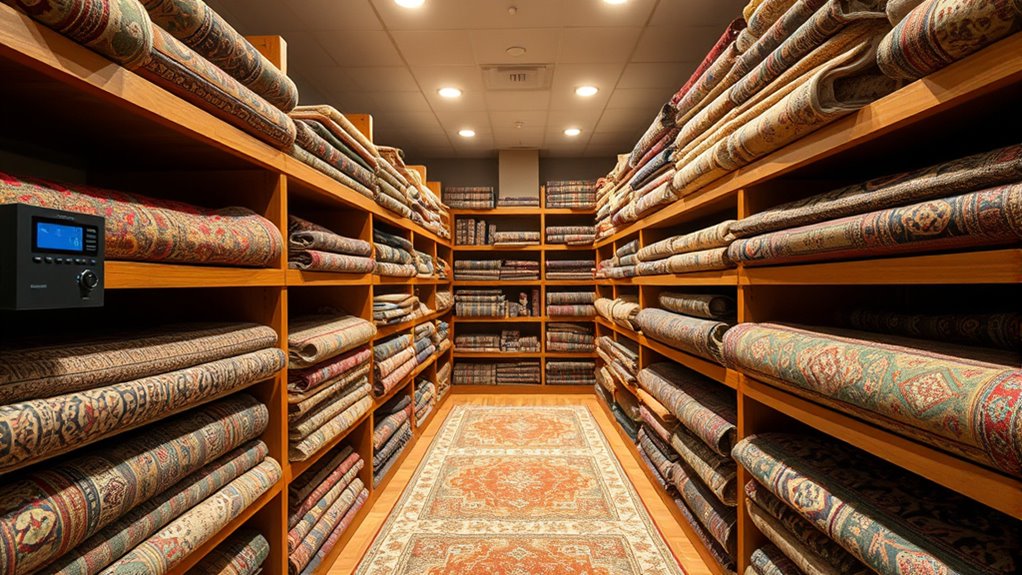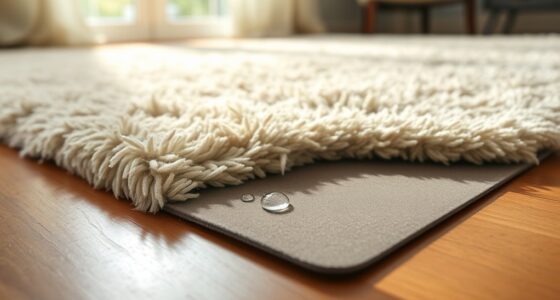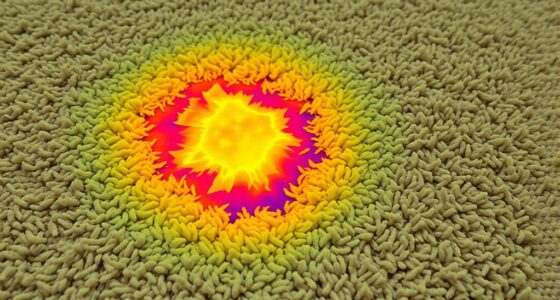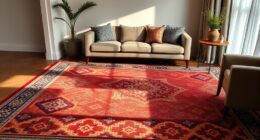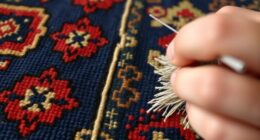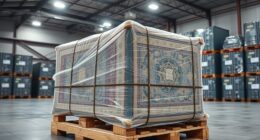To safeguard antique carpets, you should store them in a climate-controlled environment that maintains consistent temperature and humidity levels, ideally around 65-70°F and 50-55% humidity. Proper storage minimizes exposure to sunlight, pests, and environmental fluctuations that can cause fading, mold, and fiber damage. Using acid-free materials and careful handling further preserves their beauty. Keep your collection in ideal conditions to ensure longevity, and discovering more ways to safeguard your carpets is just ahead.
Key Takeaways
- Maintain stable temperature (65-70°F) and humidity (50-55%) to prevent dye fading and fiber deterioration.
- Use advanced insulation and filtration systems to monitor and control environmental conditions effectively.
- Protect carpets from direct sunlight, drafts, and moisture to preserve color vibrancy and structural integrity.
- Store carpets in breathable, acid-free materials and avoid cardboard boxes to prevent pests and chemical damage.
- Conduct regular environmental and physical inspections, collaborating with conservation experts for optimal long-term preservation.
Understanding the Importance of Proper Storage Conditions
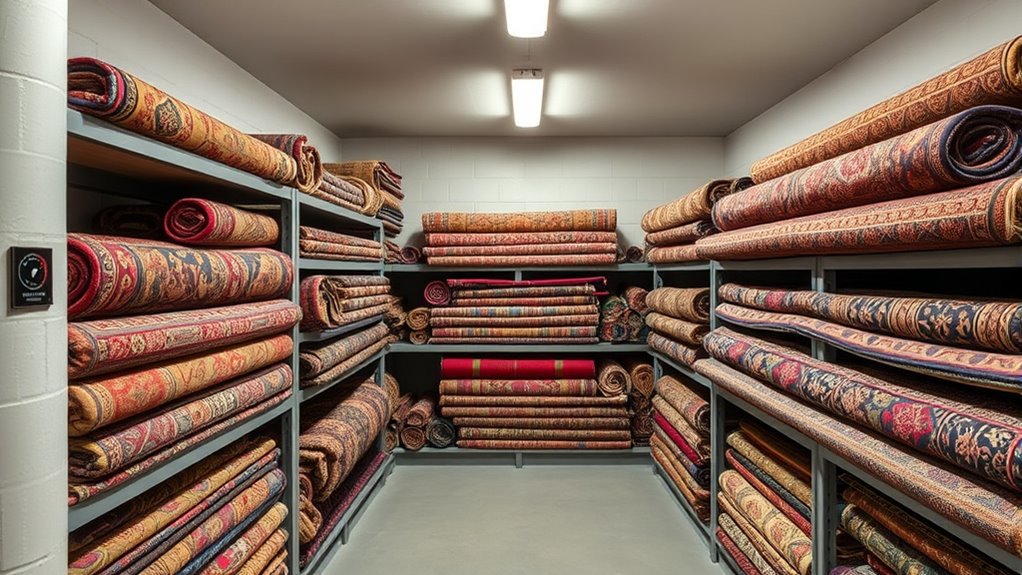
Proper storage conditions are essential to preserving the beauty and integrity of antique carpets. Vintage dyes, often used in antique weaving, are delicate and susceptible to fading if exposed to unfavorable environments. Maintaining stable conditions helps prevent color deterioration and preserves the original craftsmanship. Temperature fluctuations and humidity changes can weaken fibers and cause dyes to bleed or fade, compromising the carpet’s value. By ensuring consistent, controlled conditions, you protect the intricate details of antique weaving and extend the lifespan of your treasured piece. Proper storage not only safeguards the vibrant hues but also maintains the structural integrity of the fibers, ensuring your antique carpet remains stunning for generations to come. Climate‑controlled storage is an effective method to achieve these optimal conditions. Keep in mind, careful storage is the key to long-term preservation.
Key Elements of Climate Control for Antique Carpets
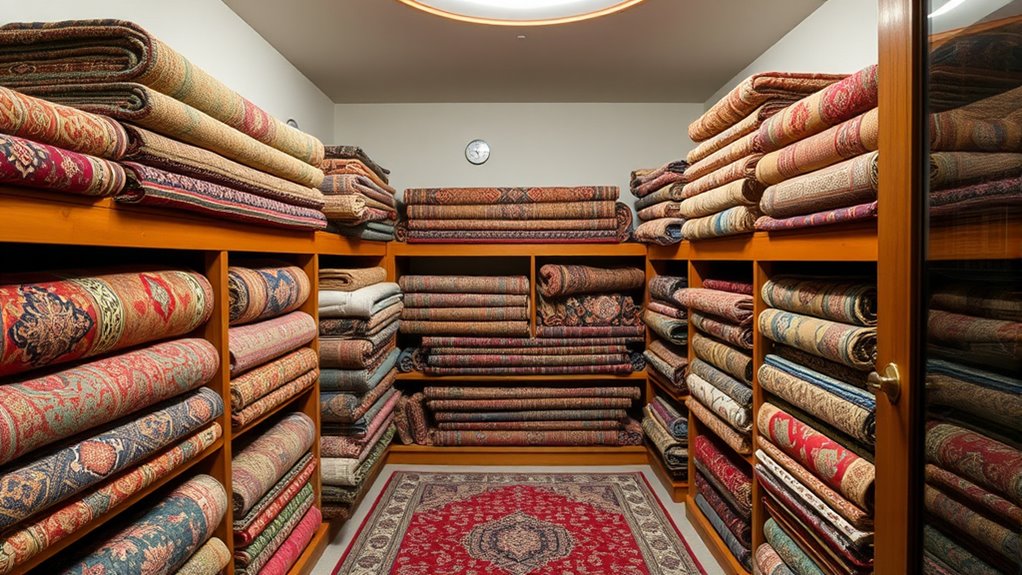
Maintaining the right climate conditions is essential for safeguarding antique carpets from damage over time. Key elements include using eco-friendly materials in your storage environment to minimize chemical exposure and reduce environmental impact. Modern storage solutions incorporate advanced insulation and filtration systems that help regulate temperature and airflow consistently. You should also guarantee your storage space avoids direct sunlight and fluctuations in temperature, which can cause fibers to weaken or fade. Proper ventilation prevents mold and mildew, protecting your carpets’ integrity. By combining eco-friendly materials with modern storage solutions, you create a stable environment that preserves the delicate fibers and dyes of your antique carpets, ensuring they remain in pristine condition for generations to come. Additionally, understanding how contrast ratio influences image quality can help you optimize your display conditions for viewing your stored carpets in detailed detail.
Benefits of Using Humidity and Temperature Regulation Systems

Using humidity and temperature regulation systems helps keep your antique carpets in top condition. They preserve the material’s integrity, prevent mold from forming, and keep colors vibrant over time. These systems are essential for protecting your valuables from environmental damage. Incorporating angel number symbolism into your maintenance routines can also serve as a reminder of the importance of harmony and balance in caring for your collection.
Preserves Material Integrity
When humidity and temperature levels are carefully regulated, the delicate materials of antique carpets are less likely to suffer damage or deterioration over time. This control helps maintain the carpet’s original fibers, dyes, and weave integrity. UV protection prevents fading caused by sunlight, while stable conditions reduce the need for harsh chemical treatments that can weaken fibers. Proper storage also minimizes exposure to pollutants that accelerate aging. Here’s how these benefits work together:
| Benefit | Effect | Result |
|---|---|---|
| UV Protection | Prevents fading of dyes | Vibrant colors preserved |
| Temperature Control | Stabilizes material expansion and contraction | Reduced fiber stress |
| Chemical Treatments | Minimize use through optimal conditions | Longer-lasting appearance |
Additionally, implementing proper storage techniques ensures these environmental controls are most effective in preserving your antique carpet’s condition.
Prevents Mold Growth
Proper humidity and temperature regulation are essential in preventing mold growth on antique carpets. Excess moisture creates an ideal environment for mold, which can quickly damage the textile’s integrity and compromise its historical significance. By maintaining consistent conditions, you reduce the risk of mold spores settling and multiplying, saving you from costly antique carpet cleaning efforts later. Using climate-controlled storage ensures your carpets stay dry and free from dampness, which is crucial for preserving their value. Mold can also cause discoloration and deterioration, making proper regulation even more vital. With stable humidity levels, you protect both the physical and historical aspects of your antique carpets, allowing you to enjoy their beauty and significance for generations to come. Implementing advanced storage solutions can further optimize preservation conditions and safeguard your priceless textiles.
Maintains Color Vibrancy
Maintaining consistent humidity and temperature levels is essential for preserving the vibrant colors of antique carpets. Fluctuations can cause dyes to fade or bleed, compromising their original beauty. Humidity and temperature regulation systems help you achieve ideal conditions that support color preservation, ensuring your carpets retain their rich hues over time. By controlling environmental factors, you prevent damage caused by dryness or excess moisture, which can dull or distort colors. This stability not only safeguards the carpet’s visual appeal but also enhances its overall aesthetic. When you keep conditions steady, you preserve the intricate patterns and vivid tones that make antique carpets unique. Additionally, cybersecurity vulnerabilities in climate control systems highlight the importance of safeguarding your environmental controls against digital threats. Ultimately, proper climate control helps your collection look vibrant and well-maintained for years to come.
Choosing the Right Storage Environment for Preservation
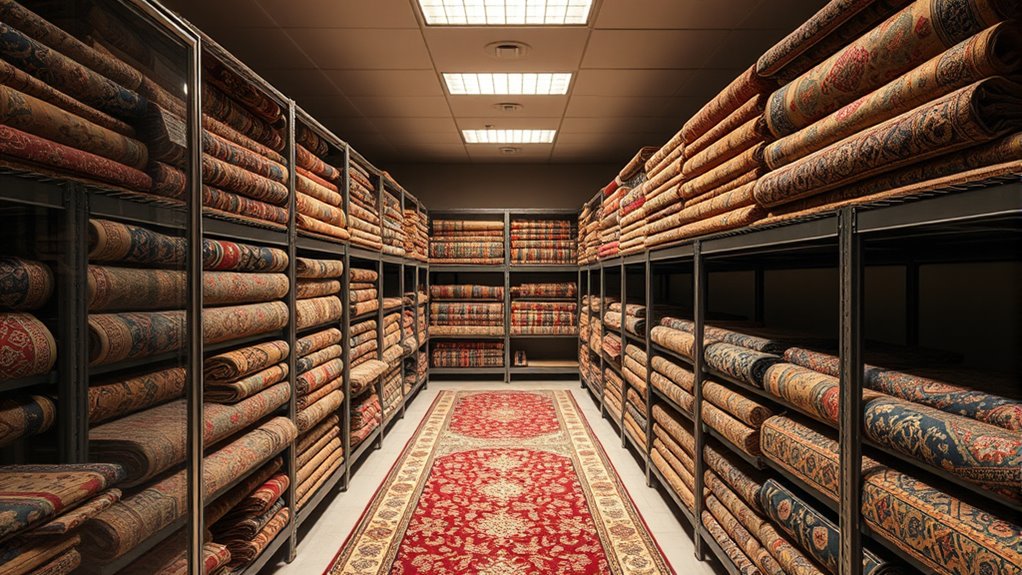
Choosing the right storage environment is crucial for preserving antique carpets, as fluctuations in temperature and humidity can cause irreversible damage. You should guarantee the space offers consistent conditions, with stable temperatures around 65-70°F and humidity levels between 50-55%. UV protection is essential; direct sunlight and harsh lighting can fade dyes and weaken fibers. Use lighting considerations to minimize exposure—prefer low-intensity, UV-filtered lighting or keep carpets covered in darkness when not displayed. Avoid areas with drafts, moisture, or fluctuating conditions that can accelerate deterioration. Proper ventilation is also important to prevent mold and musty odors. By controlling these factors, you create an ideal environment that safeguards your carpets from aging prematurely and maintains their beauty for generations.
Preventing Common Deterioration Factors in Antique Textiles
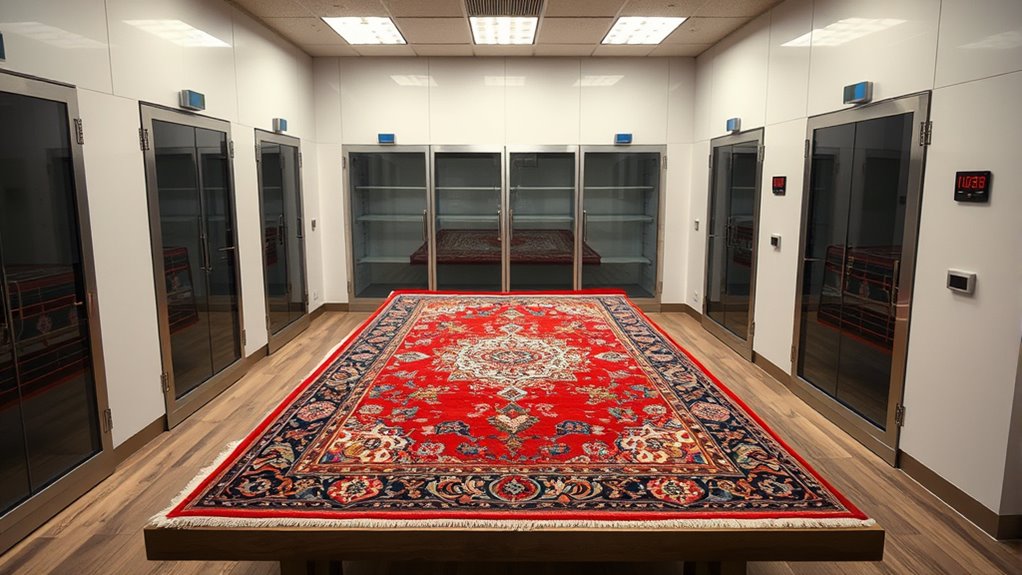
Controlling humidity levels is essential to prevent mold and fiber weakening in your antique textiles. You should also take steps to keep pests like moths and beetles away, as they can cause significant damage. By managing these factors, you’ll help preserve the integrity and beauty of your textiles for years to come. Additionally, implementing field recording techniques can aid in monitoring environmental conditions and detecting early signs of deterioration.
Humidity Control Importance
Humidity levels play a crucial role in preserving antique carpets, as fluctuations can accelerate deterioration. Too much moisture promotes mold growth and fiber weakening, while dry conditions cause fibers to become brittle. To maintain stability, you should use humidity sensors to monitor levels precisely. When moisture exceeds ideal ranges, dehumidification methods come into play, such as desiccants or dehumidifiers, to remove excess humidity. Regularly checking sensors ensures consistent conditions. Proper humidity control prevents common issues like mold, mildew, and fiber degradation, keeping your carpets in excellent condition. Additionally, utilizing air quality indicators can help detect other pollutants that may contribute to deterioration.
Pest Prevention Strategies
Maintaining proper humidity levels helps prevent mold and fiber weakening, but safeguarding antique textiles also requires vigilance against pests. To do this, use pest resistant materials, such as acid-free tissue or cotton covers, to protect your carpets from insects and rodents. Regular inspections help catch infestations early before significant damage occurs. Implement rodent deterrent measures like sealing entry points, installing traps, or using natural repellents such as peppermint oil. Keep storage areas clean and clutter-free to eliminate pest hiding spots. Avoid cardboard boxes, which attract pests; instead, opt for archival-quality storage containers. Incorporating pest prevention strategies and maintaining an environment less appealing to pests ensures your antique textiles remain intact and preserved for generations to come.
Best Practices for Handling and Packing Antique Carpets
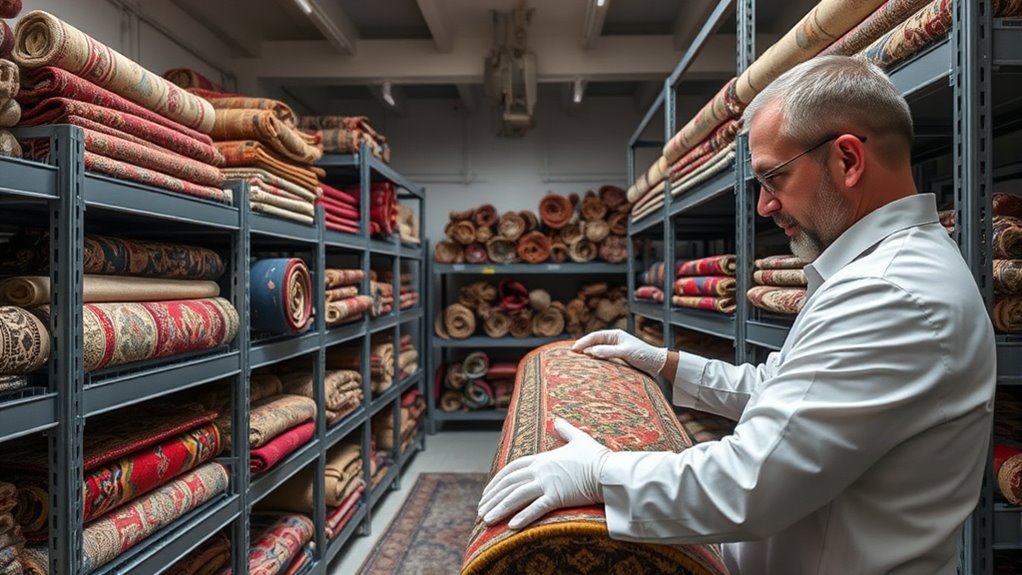
When handling and packing antique carpets, careful attention is essential to prevent damage and preserve their value. Always lift the carpet from the edges rather than the center to avoid stressing the fibers. Use clean, soft gloves to prevent oils and dirt from transferring onto the textile. When rolling the carpet, roll it tightly with the pile facing inward, and avoid folding to prevent creases. Proper packing materials, like acid-free tissue paper and breathable wrapping, protect against dust and environmental changes. For antique carpet restoration and ensuring accurate historical carpet valuation, handle the piece gently and avoid unnecessary exposure to light or moisture. Document any existing damage before packing, and always store in a climate-controlled environment to maintain its integrity. Incorporating automation technologies can further assist in monitoring storage conditions and maintaining optimal preservation environments.
Long-Term Conservation Strategies for Antique Carpet Collections
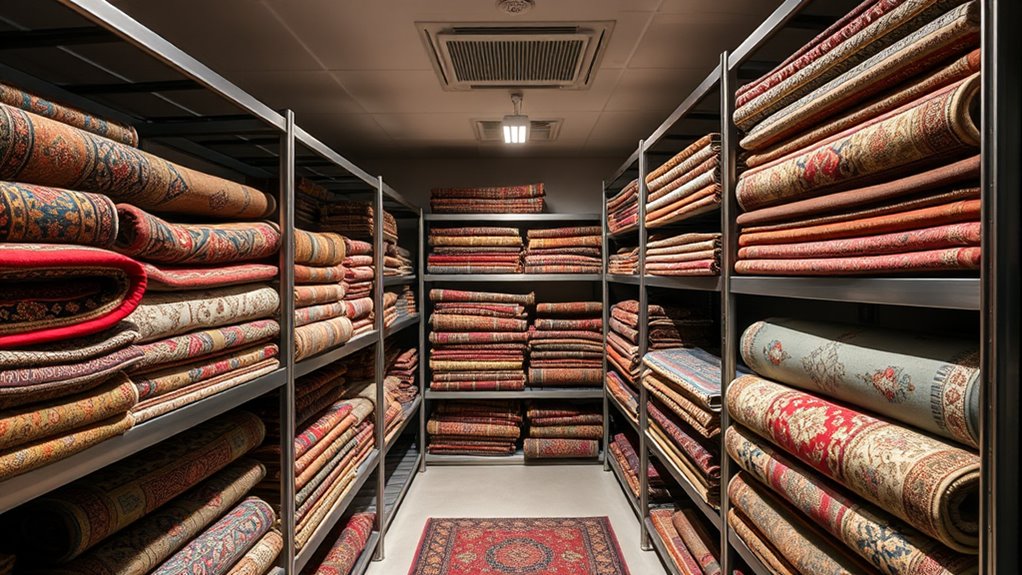
Proper handling and packing lay the groundwork for preserving antique carpets, but long-term conservation requires ongoing strategies to protect these textiles over decades. To maintain their beauty and structural integrity, focus on preserving authentic antique carpet design and regional carpet styles. Regular inspection helps identify early signs of deterioration. Implement controlled environments with stable temperature and humidity to prevent damage. Use acid-free storage materials and avoid direct sunlight, which can fade colors. Rotate carpets periodically to minimize stress on specific areas. Educate yourself on the unique features of regional carpet styles to identify issues early. Additionally, collaborate with conservation specialists to develop tailored care plans. Prioritizing these strategies ensures your antique carpet collection remains vibrant and intact for future generations.
Frequently Asked Questions
How Does Climate Control Affect the Color Retention of Antique Carpets?
You might wonder how climate control impacts your antique carpet’s colors. It plays a vital role in dye preservation, preventing the dyes from fading over time. Without proper climate control, exposure to humidity and temperature fluctuations can accelerate color fading, diminishing its beauty. By maintaining a stable environment, you help guarantee the vibrancy and integrity of your antique carpet’s colors, preserving its value and charm for years to come.
Are There Specific Storage Materials Recommended for Antique Carpets?
You’re safeguarding a treasure, so choosing the right storage materials is vital. Opt for acid-free, breathable fabrics like cotton or linen to prevent mold and deterioration. Avoid plastic, which can trap moisture and cause damage. Incorporate preservation techniques like rolling or stacking carefully, and store in a cool, dry place. Your attention to proper storage materials ensures your antique carpet’s beauty lasts for generations.
How Often Should Storage Conditions Be Monitored and Adjusted?
You should check your storage conditions regularly, ideally once a month, to maintain ideal humidity levels and prevent temperature fluctuations. Keep an eye on these factors to avoid damage from mold, pests, or deterioration. If you notice any changes, adjust the climate controls promptly. Consistent monitoring helps preserve your antique carpets’ integrity, ensuring they stay in excellent condition for years to come.
Can Climate-Controlled Storage Improve the Lifespan of Fragile Dyes?
Think of fragile dyes as delicate butterflies needing a safe haven. Climate-controlled storage acts like a gentle breeze, preserving their beauty. By providing UV protection and humidity regulation, it prevents fading and deterioration. You guarantee your antique carpets stay vibrant longer, as the stable environment minimizes stress on the dyes. This careful climate control is essential to extend the lifespan of your cherished pieces, keeping their colors vivid for generations to come.
What Are the Cost Implications of Climate-Controlled Storage Versus Traditional Storage?
When comparing storage options, you’ll find that climate-controlled storage has higher upfront costs, but it often reduces long-term maintenance expenses by preventing damage. The cost comparison shows higher rent and energy bills, but it offers better protection for delicate items. If you prioritize preserving your antique carpets and minimizing future repairs, investing in climate-controlled storage could be worth the extra expense.
Conclusion
By maintaining the perfect climate, you can guarantee your antique carpets stay pristine for centuries—perhaps even longer than you ever imagined! Proper storage isn’t just a good idea; it’s your secret weapon against time itself, turning back the clock on deterioration. With the right climate controls, your collection will remain vibrant and flawless, defying nature’s relentless march. Never underestimate the power of climate-controlled storage—it’s truly your ultimate safeguard against the unstoppable forces of decay!
